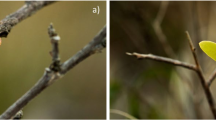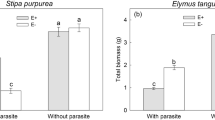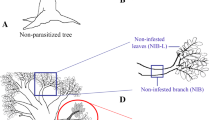Abstract
It has been reported that parasitic vascular plants (hemiparasites and holoparasites) may affect host fitness, but the effects produced by root endophyte holoparasitic species on its host have not been documented. Here the effect of the holoparasitic endophyte Bdallophyton americanum (R. Br.) Harms on the root conductivity of Bursera simaruba (L.) Sarg. was studied. Parasitized and non-parasitized root segments were sampled in the rainy and dry seasons in a dry coastal forest in central Veracruz, Mexico. Root diameter, hydraulic (K h) and specific conductivity (K s = K h/root transverse area), percent loss of conductivity and reproductive specific conductivity (K h /inflorescence or infructescense dry weight) data were obtained. The diameter and number of conductive and non-conductive vessels were recorded in parasitized and non-parasitized root segments in the dry season. Root diameters were not different between root types and seasons, but root specific conductivity was different both between seasons and root types. Specific conductivity on parasitized roots was 61% (wet season) and 85% (dry season) lower than that recorded for non-parasitized roots in the wet season. Root hydraulic conductivity was positively related with the biomass of reproductive structures of B. americanum in the wet season. The parasite appears to alter the xylem morphogenesis of the host, reducing vessel number by 40%, but not plugging or otherwise harming the conductive vessels, and resulted in no change in vessel diameter. Contrary to what has been reported to occur in some plant stems infected with hemiparasitic mistletoes, B. americanum decreases but does not eliminate conductivity to the distal plant parts.


Similar content being viewed by others
References
Ackroyd RD, Graves JD (1997) The regulation of the water potential gradient on the host and parasite relationship between Sorghum bicolor and Striga hermonthica. Ann Bot 80:649–656
Baker FA, Kavanangh K, Zaerr JB (1994) Root disease reduces hydraulic conductivity of mature Douglas-fir and grand fir roots. In: Johansson M, Stenlid J (eds) Proceedings of the eighth international conference on root and butt rots. IUFRO Working Oarty Wik, Sweden and Haikko, pp 166–175
Bloomfield J, Vogt K, Wargo PM (1996) Tree root turnover and senescence. In: Waisel Y, Eshel A, Kafkafi U (eds) Plant roots. The hidden half. Marcel Dekker. Inc., New York, pp 363–381
Castillo-Campos G, Medina ME (2002) Árboles y arbustos de la Reserva Natural de La Mancha, Veracruz. Instituto de Ecología, A.C., Xalapa, Ver.
Ehleringer JR, Marshall JD (1995) Water relations. In: Press MC, Graves JD (eds) Parasitic plants. Chapman and Hall, London, pp 125–140
Fernandes GW, de Mattos EA, Franco AC, Luttge U, Ziegler H (1998) Influence of the parasite Pilostyles ingae (Rafflesiaceae) on some physiological parameters of the host plant, Mimosa naguirei (Mimosaceae). Botanica Acta 111:51–54
Fisher JT (1983) Water relations of mistletoes and their hosts. In: Calder M, Bernhardt P (eds) The biology of mistletoes. Academic Press, Sydney, pp 161–183
García-Franco JG (1996) Biología de Bdallophyton bambusorum Liebm. (Rafflesiaceae). PhD Thesis. Facultad de Ciencias, UNAM, México DF
García-Franco JG, Rico-Gray V (1996) Distribution and host specificity in the holoparasite Bdallophyton bambusarum (Rafflesiaceae) in a tropical deciduous forest in Veracruz, Mexico. Biotropica 28:759–762
García-Franco JG, Rico-Gray V (1997) Reproductive biology of the holoparasitic endophyte Bdallophyton bambusarum (Rafflesiaceae). Bot J Linn Soc 123:237–247
Gomes AL, Fernandes GW (1994) Influence of parasitism by Pilostyles ingae (Rafflesiaceae) on its host plant, Mimosa naguirei (Leguminosae). Ann Bot 74:205–208
Graves JD (1995) Host-plant responses to parasitism. In: Press MC, Graves JD (eds) Parasitic plants. Chapman and Hall, London, pp 206–225
Gómez LD (1983) Parasitic plants. In: Janzen DH (ed) Costa Rican natural history. The University of Chicago Press, Chicago, pp 292–298
Hawksworth FG (1983) Mistletoes as forest parasites. In: Calder M, Bernhardt P (eds) The biology of mistletoes. Academic Press, Sydney, pp 317–333
Heywood VH (1978) Flowering plants of the world. Oxford University Press, Oxford
Kavanagh T, Kellman M (1992) Seasonal pattern of fine root proliferation in a tropical dry forest. Biotropica 24:157–170
Kuijt J (1969) The biology of parasitic flowering plants. University of California Press, Berkeley and Los Angeles
Joseph G, Kelsey RG, Thies WG (1998) Hydraulic conductivity in roots of ponderosa pine infected with black-stain (Leptographium wageneri) or annosus (Heterobasidion annosum) root disease. Tree Physiol 18:333–339
Lyford WH (1975) Rhizography of non-woody roots of trees in forest floor. In: Torrey JG, Clarkson DT (eds) The development and function of roots. Academic Press, London, pp 179–196
Meijer W (1993) Rafflesiaceae. In: Kubitzki K (ed) The families and genera of vascular plants. II Flowering plants Dicotyledons. Springer-Verlag, Berlin, pp 557–563
Medel R, Botto-Mahan C, Smith-Ramírez C, Méndez MA, Ossa CG, Caput L, Gonzles WL (2002) Historia Natural de una relación parsito-hospedero: el sistema Tristerix-cactceas en Chile semirido. Rev Chil Hist Nat 75:127–140
Moreno-Casasola P, van der Maarel E, Castillo S, Huesca ML, Pisanty I (1982) Ecología de dunas costeras: estructura y composición en el Morro de la Mancha, Ver Biotica (Mex.) 7:491–526
Norton DA, Carpenter MA (1998) Mistletoes as parasites: host specificity and speciation. Trends Ecol Evol 13:101–105
Ortíz-Pulido R (1994) Frugivoría y dispersión de semillas por aves en el Morro de La Mancha, Ver Bachelor Thesis, Facultad de Biología, Universidad Veracruzana, Xalapa, Ver. México
Pennington TD, Sarukhn J (1998) Árboles tropicales de México. Universidad Nacional Autónoma de México and Fondo de Cultura Económica, México DF
Riches CR, Parker P (1995) Parasitic plants as weeds. In: Press MC, Graves JD (eds) Parasitic plants. Chapman and Hall, London, pp 226–255
Sperry JS, Donnelly JR, Tyree MT (1988) A method for measuring hydraulic conductivity and embolism in xylem. Plant Cell Environ 11:35–40
Stewart GR, Press MC (1990) The physiology and biochemistry of parasitic angiosperms. Ann Rev Plant Physiol Plant Mol Biol 41:127–151
Thompson JN (1982) Interaction and coevolution. Wiley-Interscience, New York
Tyree MT, Ewers FW (1991) The hydraulic architecture of trees and other woody plants. New Phytol 119:345–360
Acknowledgements
We thank L. Ríos F. for helping us with the field and lab work, and to E. López and A. P. García for their kind hospitality at CICOLMA. Comments and suggestions from F. W. Ewers and two anonymous reviewers greatly improved the quality of the manuscript. The research was supported partially by Instituto de Ecología, A.C. (902-17-144, 902-17-016 and 902-15-666) and the Mexican National Council of Science and Technology (CONACYT; grant to JLP No. 25935-N).
Author information
Authors and Affiliations
Corresponding author
Additional information
Communicated by K. Winter
Rights and permissions
About this article
Cite this article
García-Franco, J.G., López-Portillo, J. & Ángeles, G. The holoparasitic endophyte Bdallophyton americanum affects root water conductivity of the tree Bursera simaruba . Trees 21, 215–220 (2007). https://doi.org/10.1007/s00468-006-0113-z
Received:
Revised:
Accepted:
Published:
Issue Date:
DOI: https://doi.org/10.1007/s00468-006-0113-z




